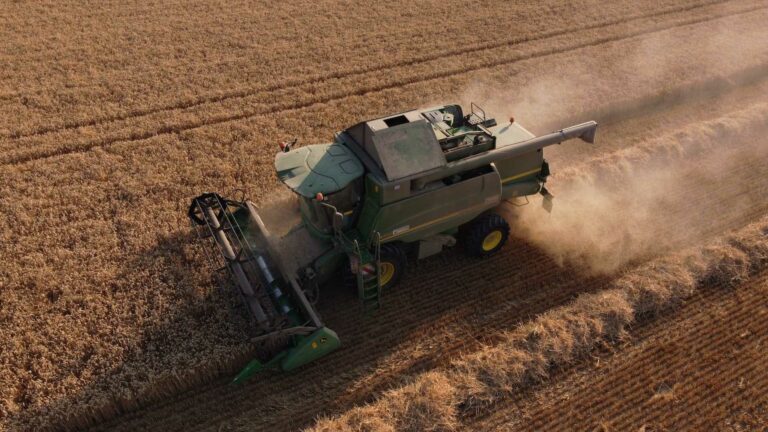Running a small farm means getting creative with space, time, and equipment. Every decision has a ripple effect: how grain is stored affects how quickly you can dry it, how much you lose to spoilage, and how smoothly the next harvest cycle begins. And unlike large commercial operations, small farms don’t always have the luxury of endless storage space or high-capacity machinery — which makes an efficient grain-handling system even more important.
The good news? A few well-planned changes can make everyday workflows faster, cleaner, and easier to manage. In the sections below, we’ll look at the practical steps small farms can take to reduce bottlenecks, cut losses, and keep grain moving smoothly from harvest to storage.
Table of Contents
Start With Storage That Matches Your Operation Size
One of the biggest challenges small farms face is balancing limited space with fluctuating harvest volumes. Oversized grain systems can be expensive, but too-small setups lead to backups, mixing issues, and unnecessary stress during peak season.
This is where it helps to think in terms of right-sized storage instead of simply bigger storage. Smaller, modular options — like a small grain bin that can be added or rearranged as the farm grows — offer flexibility without forcing a major investment all at once. They’re also easier to place near fields or loading areas, reducing travel time during busy days.
Systems like the mini bins offered by Farm and Ranch Depot are designed with this exact need in mind: compact, durable, and capable of supporting small operations without the complexity of commercial-scale bins.
But storage is only one piece. Once grain is in the bin, what happens next matters just as much.
Improve Your Grain Flow With Better Organization and Layout
A surprisingly common inefficiency on small farms comes from the layout of the grain handling system itself. When paths overlap or equipment isn’t placed logically, even a simple harvest day becomes slow and labor-heavy.
A few strategic adjustments can make a big difference:
- Position storage close to the combine’s unloading path.
- Keep dryers or aeration fans within easy reach of the bins.
- Ensure there’s enough room around bins for safe access and quick loading.
These changes may sound small, but in practice, they cut down on repeated trips, long equipment movements, and time spent maneuvering in tight spaces. A cleaner layout also reduces the risk of contamination by keeping high-traffic areas separate from storage areas.
A good rule of thumb: every extra step adds cost, whether it’s fuel, time, or labor.
Use the Right Tools for Moving Grain, Not Just Storing It
Storing grain efficiently is important — but moving it efficiently is what keeps the entire system running.
Small farms benefit most from simple, reliable moving solutions: augers, conveyors, and gravity-fed systems that are easy to maintain yet fast enough to prevent pileups. Grain tends to move inconsistently when equipment is worn out or undersized, and that inconsistency leads to slower drying, uneven loading, and potential spoilage.
If grain handling feels like the slowest part of your operation, upgrading movement tools often provides a bigger improvement than upgrading storage.
Prioritize Drying and Moisture Control Early
Moisture issues rarely show up right away — but when they do, they’re costly. Poor airflow inside a bin can lead to:
- Hot spots
- Mold
- Clumping
- Reduced grain quality
For small farms, preventing this is more efficient than trying to fix it later.
Two simple upgrades dramatically improve drying:
1. Strong airflow – Even small bins benefit from quality aeration fans.
2. Even fill levels – Level grain dries more consistently and prevents trapped pockets of moisture.
If you notice grain crusting or clumping at the top, that’s your first sign that airflow isn’t reaching the center efficiently. Improving drying early helps keep grain in top condition for longer periods — especially through winter storage.
Reduce Losses Through Better Monitoring
Small farms don’t always have high-tech sensors or automated monitoring systems, and that’s completely fine — manual monitoring still works well when done consistently.
Check for:
- Temperature changes
- Condensation on bin walls
- Any sour or musty smell
- Signs of pest activity
These issues start small but grow fast. Quick checks every few days during the early storage period can prevent thousands of dollars in loss later.
If you want to step things up without large investment, portable temperature probes and simple moisture testers offer a big upgrade for very little cost.
Keep Maintenance Simple and Regular
A grain system doesn’t need to be complicated to be efficient. What matters most is consistency.
Small improvements like these go a long way:
- Clean augers regularly
- Lubricate moving parts before heavy use
- Check bin seals before rainy seasons
- Keep loading areas free from debris
When every piece of equipment is running smoothly, you avoid slowdowns and reduce the risk of breakdowns during the busiest times of the year.
Conclusion
Improving grain handling on a small farm isn’t about installing the biggest system — it’s about creating a setup that works with your land, your workload, and your goals. When storage fits your space, movement tools match your volume, and the workflow is organized, everything becomes smoother.
Start with manageable upgrades, focus on consistent monitoring, and use right-sized equipment that supports your scale. A few thoughtful changes today can turn harvest into a faster, cleaner, and far less stressful part of farm life.


